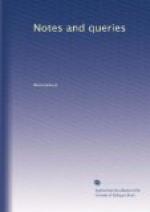Now this is a relation that we are well content, although unsupported by contemporaneous authority, to receive on tradition; because in the nature of the circumstances we cannot expect to find any authentic evidence of the occurrence. But we should never think of citing these passages as fixing the fact of the blow, as chronicled by Hall, in opposition to the milder representation of the story as told by Sir Thomas Elliott in “The Governour.” The bard makes that selection between the two versions which best suits the scene he is depicting.
We cannot, however, be so easily satisfied with the second fact,—the reappointment of Gascoigne,—thus asserted by Shakspeare when making Henry say:
“You did commit me;
For which, I do commit into your hand
The unstain’d sword that you have
us’d to bear;
With this remembrance,—that
you use the same
With the like bold, just, and impartial
spirit,
As you have done ’gainst me.”
We require better evidence for this than tradition, because, if true, better evidence can be adduced. A noble writer has very recently declared that he can “prove to demonstration that Sir William Gascoigne survived Henry iv. several years, and actually filled the office of Chief Justice of the King’s Bench under Henry V.” As to the first of these points he implicitly follows Mr. Tyler’s history, who proves that Gascoigne died in December 1419, in the seventh year of the fifth Henry’s reign; but as to the second point, deserting his authority and omitting the dates introduced in it, he entirely fails in supporting his assertion. The assertion, however, having been made in so recent a work, it becomes important to investigate its truth.
The only fact that gives an apparent authenticity to the story is that Gascoigne was summoned to the first parliament of Henry V. as “Chief Justice of our Lord the King.” When we recollect, however, that this summons was dated on March 22, 1413, the day following the king’s accession, we must see that his Majesty could have had little more time than to command a parliament to be summoned; that the officer who made out the writs would naturally direct them to those peers, judges, and others who were summoned to the preceding parliament; and that the proper title of Gascoigne was Chief Justice until he was actually superseded. This evidence, therefore, is anything but conclusive, and in fact gives very little assistance in deciding the point at issue.
It is well known that Sir William Hankford was Gascoigne’s successor as Chief Justice of the King’s Bench, and the real question is, when he became so. Dugdale states that the date of his patent was January 29, 1414, ten months after King Henry’s accession; and if this were so, the presumption would follow that Gascoigne continued Chief Justice till that time. Let us see whether facts support this presumption.
Now, Hankford was a Judge of the Common Pleas at the end of the previous reign; but he was omitted when his brethren of that court received their new patents from Henry V., which were not issued till May 2, a day or two before Easter Term. And yet we find the name of Hankford in the Year-book reports of both that and Trinity Term; and we find it, not as acting in the Common Pleas, but as ruling in the King’s Bench.




